Veteran’s Testimony – Everard R. Hicks Medical Detachment, Headquarters Battery, 924th Field Artillery Battalion, 99th Infantry Division
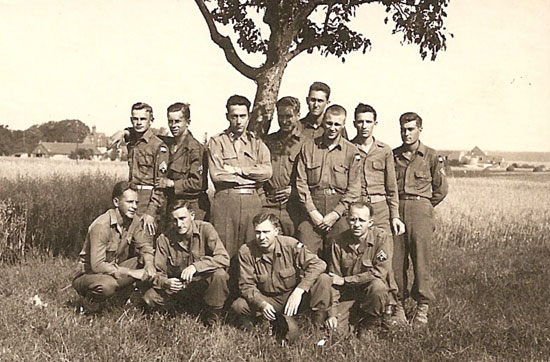
Group picture illustrating the Medical Detachment, Headquarters Battery, 924th Field Artillery Battalion (total: 12 men). Picture taken in Germany (1945).
Captain Bernerd H. Burbank, Battalion Surgeon stands in the middle (with crossed arms).
Introduction:
My name is HICKS, Everard, Raymond. I was born on 24 Feb 1919 in Hazel, Calloway County, Commonwealth of Kentucky, U.S.A. While living in Hazel, I attended Primary, Middle, and High School, and graduated in 1938. I was the President of my High School graduating class.
During the summers of 1936 and 1937, I made some money by driving a delivery truck in western Kentucky and Tennessee for $ 1.00 per day.
After 2 years of College, I started training to become a Nurse. I went to the “William Mason Memorial Hospital” (my Grandfather’s Hospital) in Murray, Kentucky to become a male Nurse. The Hospital was a 65-bed medical installation established in 1910, which would serve the community until 1947. As part of our training we attended classes at “Murray State College” where we took courses in basic science, chemistry, nutrition, and biology.
I graduated as a (civilian) Registered Nurse in 1941. Having already been registered with the Selective Service Act, and having recently graduated, I got drafted into the Army of the United States, ASN 35257572, on 11 February 1942, and entered into service at Fort Benjamin Harrison, Indianapolis, Indiana (Finance Replacement & Training Center).
After a brief stay at Ft. Benjamin Harrison, I was sent to Cp. Barkeley, Abilene, Texas (Armored Division Camp & Medical RTC). I took 15 weeks of Basic Training and a Medical Administrative Specialist course (being already a RN) which must have started about 20 February 1942. The MRTC (activated 1 Nov 41) was commanded by Colonel Fay W. Brabson.
I was then transferred to Cp. San Luis Obispo, San Luis Obispo, California (Infantry Division Camp) and assigned to the 7th Infantry Division Field Artillery. I unfortunately don’t remember the specific Battalion to which I was assigned:
31st Fld Arty Bn (155mm) Tractor-drawn
48th Fld Arty Bn (105mm) Truck-drawn
49th Fld Arty Bn (105mm) Truck-drawn
57th Fld Arty Bn (105mm) Truck-drawn
I was attached to one of the above Artillery Battalions as a Medic. When higher Headquarters learned that I had a private pilot’s license, I was ordered to Ft. Riley, Junction City, Kansas (Cavalry RTC & School) for training as a glider pilot. My CO asked me what I wanted, and I told him I preferred to remain in the Artillery as a Medic. And so I did. I had sort of a traditional link with the medical world, my grandfather, three uncles, and an aunt were Medical Doctors, and my son later became an Oral Surgeon.

Cp. San Luis Obispo, California (March 1942). Everard R. Hicks (standing left) with a group of 7th Infantry Division fellow-Artillerymen.
From Cp. San Luis Obispo, we were sent on to the Desert Training Center, which was the largest training area in the U.S. spread over 18,000 square miles and covering parts of California, Nevada, and Arizona (initially established to train troops in desert warfare and survival – sometimes also designated the California-Arizona Maneuvers Area, i.e. CAMA), to participate in the II Armored Corps Maneuvers in the Mojave Desert (14 Aug 42 > 20 Oct 42).
Assignment:
While still on Maneuvers, I was sent as one of 1,300 Training Cadre to a new Camp, Cp. Van Dorn, Centreville, Mississippi, and assigned to the 924th Field Artillery Battalion, where we joined the (new) 99th Infantry Division (activated there on 16 Nov 42). As Cadre our job was to train all the new recruits, which we did for a period of 12-15 weeks.
Brigadier General Thompson Lawrence became the Division’s first Commanding Officer, while Colonel Harry J. Collins was appointed the unit’s Executive Officer. Lieutenant Colonel Philip R. Beckjord commanded the 324th Medical Battalion.
I then joined the Medical Detachment being attached to Headquarters Battery, 924th Artillery Battalion (105mm Howitzers) as a Medical NCO (MOS 673).
“Checkerboard” recruits who joined the Division and entered the Camp between 6 – 20 December 1942, will probably remember the early days at Cp. Van Dorn, with lots of rain, lots of red mud, the hastily-built tar paper shanty barracks, and the harsh and daily training, which started on 4 January 1943 with Cadre from the 7th Infantry Division (of which I was a member). A tragic event, was the burning down of the two Service Clubs right before Christmas, depriving the men of social facilities, and almost isolating the Camp from the world during a miserable winter … any town of more than 2,000 population was 50 or more miles away!

Vintage postcard (1925) illustrating “William Mason Memorial Hospital”, Murray, Kentucky. Originally established in 1910 as a 65-bed General Hospital it would
serve the community until 1947. Sold, renovated, and expanded, with re-opening in 1964, now redesignated Murray-Calloway County Hospital (MCCH).
Some important changes of command relating to the 99th Infantry Division took place in 1943:
21 Apr 43 – Brigadier General Harry J. Collins (XO) > promoted Commanding General 42d Infantry Division (to be activated 14 Jun 43)
9 May 43 – Colonel William B. Bradford > appointed Executive Officer (coming from the 33d Infantry Division)
30 Jul 43 – Major General Thompson Lawrence (CG) > promoted Commanding Officer Cp. Roberts, California, Infantry & Field Artillery Replacement & Training Center
2 Aug 43 – Brigadier General Walter E. Lauer > appointed new Commanding General prior to Louisiana Maneuvers
1 Feb 44 – Brigadier General Hugh T. Mayberry > appointed new Executive Officer (ex-CO Cp. Hood, Texas, Infantry & Tank Destroyer Replacement & Training Center)
From Cp. Van Dorn, our Division moved, this was 19 November 1943, to Cp. Maxey, Paris, Texas, (Division Camp) which was to become our new home. The 99th “Checkerboard” Division almost spent 10 months at Cp. Maxey preparing for actual combat. Intensive training including all possible phases of combat and technique of weapons was rehearsed, reviewed, and implemented, until everything became almost second nature to the men! During the same period, over 3,000 men were released to the 99th Infantry Division from the Army Specialized Training Program (ASTP), in order to replace personnel lost during Maneuvers who went to the 85th and 88th Infantry Divisions scheduled for an early departure overseas. They trained as a provisional Regiment until being absorbed by the Division three months later.
Movement Overseas:
After receiving our POM orders, the Division entrained for Broughton, Massachusetts, near Boston, on 15 September 1944 en route for its Staging Area Cp. Myles Standish, Massachusetts (Staging Area for Boston P/E). Trains left at all hours, day and night, heading in different directions, for a period lasting over a week, and the first groups started arriving between 10 – 13 September and later. After a number of days, with each man passing inspection, receiving several shots, and being briefed about censorship regulations, short-period passes were authorized, and the men took leave of their loved ones. After spending less than two weeks at Cp. Myles Standish, final preparations for embarkation were completed and the Division started boarding ships, including the USAT George W. Goethals, the ex-Luxury Liner Argentina, and the ex-freighters Explorer, Excelsior and Exchequer. I finally boarded a ship called the S/S Exchequer which departed Boston P/E on 29 September 1944, sailing for England.

1st Lt. Bernerd H. Burbank in ‘good’ company, with 2 Red Cross girls who served coffee & donuts to the troops …
The convoy leaving Boston harbor spent an uneventful voyage across the Atlantic, reaching the British Isles and arriving at Gourock, Scotland, on 11 October 1944. Ships then docked, and debarkation took place, bringing us to places such as Liverpool and finally ending at Blandford, England. The different Division units were then spread all over Dorset County, waiting to be transferred to continental Europe.
Arrival in the ETO:
Orders arrived and on 1 November 1944, the Division started moving its troops by rail and by motor to the southern English ports of Southampton and Bournemouth. After loading the necessary equipment and troops into various types of ships and crafts, the entire Division was moved across the English Channel between 4 – 8 November 1944, landing at Le Havre, France.
After reaching the St. Lucien assembly area, the unit was split in several motor convoys, departing for a new assembly area in Belgium. We departed in different groups, crossing Northern France toward the French-Belgian border, and reached our final destination at Aubel, Belgium, 7 November 1944, where we were to come under V Corps, First United States Army control. Our orders were to assemble, occupy defensive positions, and prepare for an attack against the Siegfried Line. The period set forth was 13 – 18 December 1944.
I quite well remember Belgium, it is really there that I had my first conversation in French. It was also a place where we enjoyed food and delicacies, but also bad memories, when thinking about the severe winter that we experienced, with freezing nights spent in shallow foxholes. Often feeling cold and wet, having no dry clothes, this was one of the worst parts of the war. The first genuine hot bath (after more than 30 days in the field) I took in a town called Verviers. Our scary confrontation with “Buzz Bombs”. Incoming enemy barrages. And above all, being confronted with death …
Battle of the Bulge:
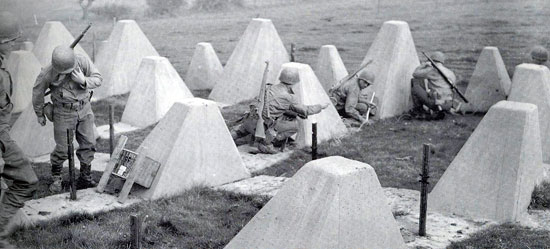
Siegfried Line 1945: American Engineers are preparing explosives in order to blow up Dragon Teeth (German antitank devices).
Unfortunately, part of the Allied offensive plan was to become severely disturbed by the sudden outbreak of a large-scale German counter-offensive which started on 16 December 1944! It had been difficult to become accustomed to the freezing cold and restricted movement caused by snow and wind. Suddenly all hell broke loose, bringing with it the additional hazards of unmerciful incoming enemy artillery fire and charging fanatic troops and armor, striking at thinly held lines of a green, untried Division with an overpowering force. Frenzied battles raged in bitter winter settings and after an initial forced withdrawal to the “Elsenborn Ridge”, the 99th Infantry Division and other American units gradually began regaining lost ground.
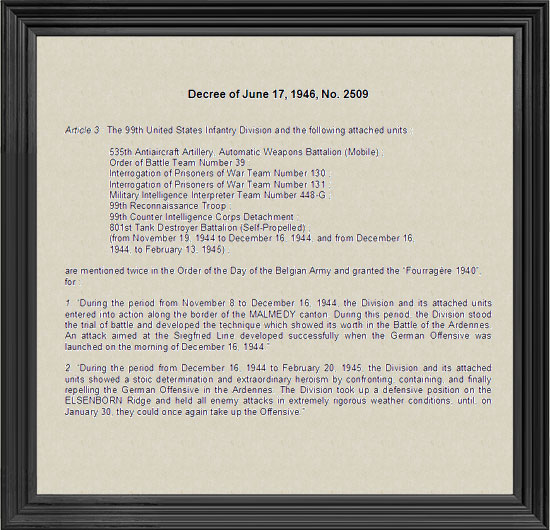
The text of above Decree reflects Article 3, the simple reason is that Decree No. 2509, was published the same day i.e. June 17, 1946, for awarding the
Fourragère to three different Army units: Article 1 > The Antwerp Antiaircraft Artillery Command (aka Antwerp X), with attached units, for the defense of the
Port of Antwerp against all-out attacks by V-1 buzz bombs, and for protection of the Port area during the German counter-offensive of December 16, 1944.
Article 2 > The 2d United States Infantry Division, with attached units, for building the Northern Shoulder and defending it against the enemy offensive
launched on December 16, 1944, and for successfully disengaging from the enemy and occupying and defending the Elsenborn Ridge against the Germans. Article 3 >
The 99th United States Infantry Division.
Please click to enlarge.
Germany:
Early 1945, this was between 5 – 6 February 1945, the “Checkerboarders” wheeled across the area where they fought their bitter fights in December, arriving at Aubel, Belgium, where the Division had previously been stationed before going into combat. After a period of rest, training, reinforcements, and maintenance, we were again ‘ready’ for war! It was now up to the “Fatherland”, to drive into enemy country, span the Rhine River, expand the “Remagen Bridgehead”, liberate and comfort Allied Prisoners of War in Moosburg, and contribute to final Victory.
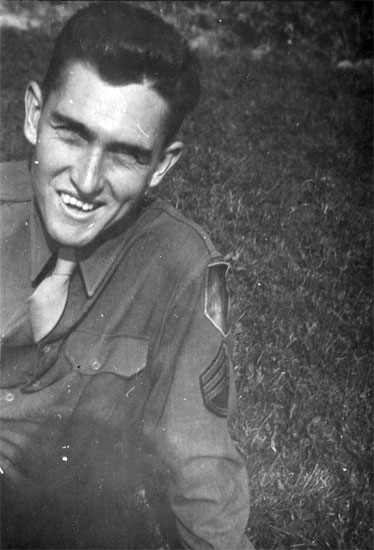
Germany, July 1945. Picture of S/Sgt Everard R. Hicks taken by a German ‘Fraülein” with his (captured) German camera. Please note, the picture was taken
after his transfer from the 99th to the 1st Infantry Division.
While advancing through Germany, we sometimes became separated from our unit, as groups were often leapfrogging one another, or being temporarily assigned to different areas, thus leaving some guys behind.
Saving, or trying to save a guy’s life was our basic doctrine! In deep snow, I was able to rescue and bring back 2 of our men who had wandered into a minefield. Stepping into their footprints I managed to bring them back under enemy fire, for which I was awarded the Bronze Star. I did sometimes carry a .45 caliber pistol to protect the wounded. When crossing the Danube, we saw a dead American Medic shot straight through the Red Cross symbol painted on his helmet!
We did save lives, but not only ‘friendly’ ones. Late one afternoon, a German civilian approached me and told me there were a number of German wounded in a nearby town. He asked whether we could help them. As the town wasn’t totally cleared of enemy troops, this was a risky business, anyway two of us went in with the German guy sitting on the jeep’s hood. We found five or six dead young German soldiers (aged between 16-17) and one still alive. I gave him plasma and brought him back to our lines, but he died during the night. The next morning I got chewed out by the CO, and was ordered to take a squad to reconnoiter the town (I had never done such thing). Back in town, we received flowers and lots of appreciative comments from the locals. I went to the Mayor’s house and told him to surrender the town or be blasted to smithereens by American artillery. He kindly obliged and out of several houses came about 300 German troops who after stacking their weapons were marched into captivity by my squad. The CO sorted out the PWs sending the old men back to town, and directing the others to a PW cage.

May 1945, picture taken in MOOSBURG, which held a large Allied PW Camp (Stalag VII-A) liberated by CCA of the 14th Armored Division on 29 April 1945.
After crossing the Danube River, we encountered a place where a German ambush had killed many Americans, but fortunately some had made it to the far bank, and even brought back a young SS prisoner. While the prisoner was being questioned, a tank pulled up to a stop and a tanker jumped out and shot the SS Lieutenant in the chest! I immediately helped the man, treating the sucking wound and administering plasma. The tanker was furious and said that if I helped the s.o.b., he would shoot me! I just stood up and told him to go ahead! The guy then walked away disgusted leaving me with the helpless patient. One of his men told me that the man’s brother had been killed the day before and he badly wanted revenge … As I continued to treat the enemy, the German Officer said the war was over for him, and showed our artillerymen the position of the German guns. I put the ‘grateful’ enemy Officer on a litter-jeep and had him transferred to a captured German Military Hospital.
It was also the first time I encountered a jet plane, not even knowing what it was, except that the noise it made and the power it developed were truly awesome. It really put the fear in us, and made everyone think Hitler now had a super weapon to fight us!
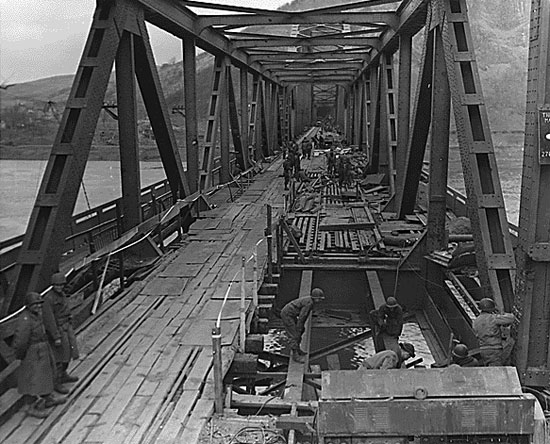
View of the “Ludendorff Bridge” at Remagen, after its capture by American troops pertaining to the 9th Armored Division, on 7 March 1945.
When coming across SS PWs, we always had a Jew interrogate them to try and make them talk. I remember there was a little Jewish Officer (a 2d Lieutenant, but I don’t remember his name), he would pull out a .45, aim it at their head while interrogating, and then shoot a bullet about an inch from their head, and believe you me, they always gave information. The IPW and CIC people used many Jews to piss off the prisoners, as most were fluent in German.
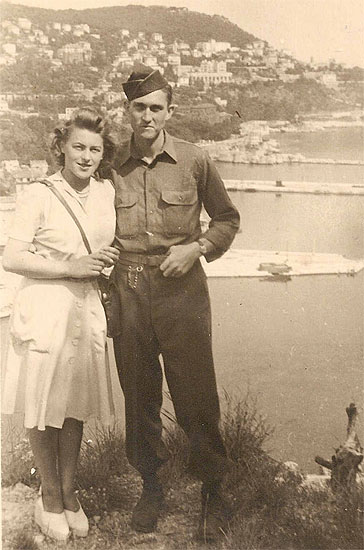
June 1945, picture of S/Sgt Everard R. Hicks with French girlfriend Ann while on R & R in Nice (French Riviera Recreational Area).
German wounded often tried to convince us to be brought in for treatment at US medical installations, the descriptions of German Military Hospitals being so horrific! Nevertheless, after triage and some preliminary treatment the majority of enemy patients were effectively returned to German Hospitals.
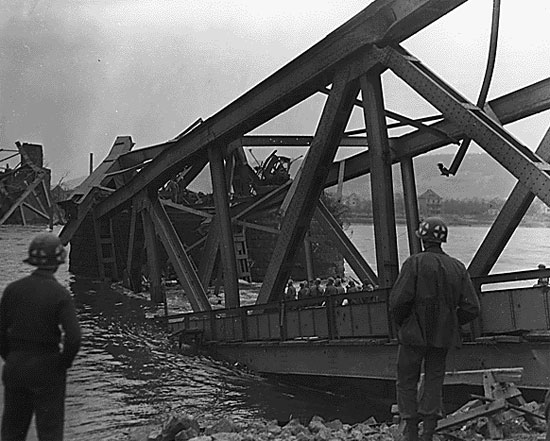
The “Ludendorff Bridge” at Remagen, after it collapsed on 17 March 1945, causing the loss of 28 US servicemen. Since Pontoon bridges had already been erected,
the incident did not cause any significant strategic loss to the American Forces in the Bridgehead.
Toward the end of the war, we would come upon numerous German soldiers who would beg us to be captured by us (Americans) so as to avoid falling into Russian hands.
Then it came – Halt! We all recall V-E Day, and 7 May 45, the day Nazi Germany surrendered unconditionally.
The End:
My Division became part of the “US Army of Occupation”, being stationed in Germany in the Main-Franken area, with Division Headquarters established at Kitzingen. SHAEF then published Redeployment & Readjustment rules (RR1), and revised them later (RR1-1). With relation to this policy, it was announced that certain units would remain in Germany, others would be selected to return stateside for demobilization, and some would be redeployed to the Pacific (the war with Japan was still on). The shooting war was now over, non-fraternization policy was still in effect, and while being busy with occupational duties, we soldiers couldn’t help but think about the day we would return home! Shows, entertainment, recreation, education, were important factors (to boost morale), but we now all focused on “points”. As was the case with other units, the 99th received quite a number of high-point men from other organizations, while low-point personnel were transferred to units that would remain in Europe (for occupation duty). The critical score was 85 points, and as I only had an ASR of 74 (2 Sep 45), I was afraid of being transferred to another unit. After R-Day, units were continuously occupied with reshuffling personnel. Upon my return from a brief stay at the “French Riviera Recreational Area ” for Enlisted Men 10 July 1945 (Nice, Southern France), I found out that the entire Medical Detachment (my unit) had just been transferred to the 33d Field Artillery Battalion (105mm How Trk-D), pertaining to the 1st Infantry Division!
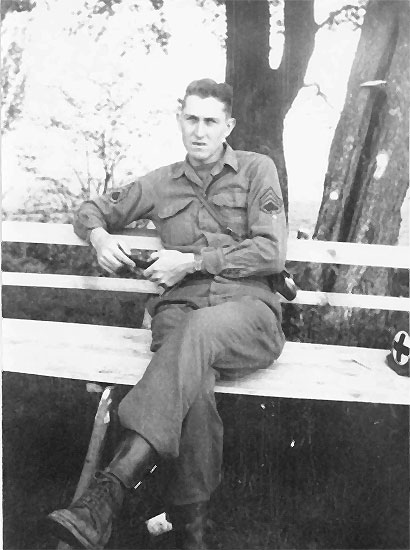
Picture taken in Germany at the end of the war (1945). Of interest is the little German camera worn by S/Sgt. E. R. Hicks on his left hip.
Meanwhile, my score had gone up, due to having been awarded the Bronze Star Medal on 20 July1945 (for my action of 6 Feb 45). I thus reached the required number of points to become eligible for Discharge. As a consequence of this improved score, I was now assigned to the Medical Detachment, 400th Armored Field Artillery Battalion (non-Divisional 105mm How S-P unit). I got my marching papers and joined my new outfit, not far from the German-Czech border, in a town called Münchberg. This transfer was a pure administrative matter, enabling me to join a unit that was earmarked for return to the Zone of Interior in order to be inactivated. The 400th Armored Field Artillery Battalion finally entrained for the Port of Marseilles (France), from where we embarked on 28 September 1945 for the United States. The vessel’s name was the S/S “Marine Devil”. We sailed the Mediterranean, passing Spain, the northern coast of Africa, Gibraltar, and after a rough trip in the Atlantic (stormy weather), we reached Hampton Roads P/E, Virginia. It was 9 October 1945. Seeing the United States again was a wonderful sight! Troops then boarded a train for Cp. Patrick Henry, Oriana, Virginia, where we got processed (this took between 1 – 3 days).
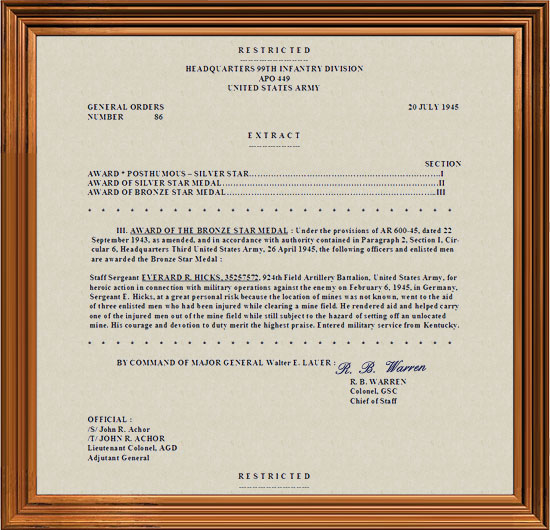
An example of the text which appeared on Everard’s award for the Bronze Star Medal.
Please click to enlarge.
I was Honorably Discharged on 14 October 1945, a Staff Sergeant with the Medical Detachment, 400th Armored Field Artillery Battalion, at Cp. Atterbury Separation Center, Columbus, Indiana. I was finally home on 16 October 1945…
Veteran’s Diary
Although violating Army Regulations, S/Sgt Hicks maintained a diary during his service with the 924th Field Artillery Battalion. The MRC Administrators are delighted to share this with you in the format of a downloadable PDF document. Please click on the download link below to view Hicks’ diary:
Download Diary (New Window)
Notes:
It might be interesting to go through some data related to the various units, S/Sgt E. R. Hicks served with overseas, during World War 2:
924th Field Artillery Battalion (105mm Howitzer, Truck-drawn)
Attachment > 99th Infantry Division
Activated > 15 Nov 42 Cp. Van Dorn, Miss.
Inactivated > 27 Sep 45 Cp. Patrick Henry, Va.
Overseas Service > England, France, Belgium, Germany
Campaigns > Rhineland (15 Sep 44 – 21 Mar 45) Ardennes-Alsace (16 Dec 44 – 25 Jan 45) Central Europe (22 Mar 45 – 11 May 45)
33d Field Artillery Battalion (105mm Howitzer, Truck-drawn)
Attachment > 1st Infantry Division
Activated > 1 Oct 40 Ft. Ethan Allen, Vt.
Inactivated > active thru 1946 Europe (later served in Vietnam)
Overseas Service > Scotland, North Africa, Sicily, England, France, Germany
Campaigns > Algeria-French Morocco (8 Nov 42 – 11 Nov 42) Tunisia (17 Nov 42 – 13 May 43) Sicily (9 Jul 43 – 17 Aug 43) Normandy (6 Jun 44 – 24 Jul 44) Northern France (25 Jul 44 – 14 Sep 44) Rhineland (15 Sep 44 – 21 Mar 45) Ardennes-Alsace (16 Dec 44 – 25 Jan 45) Central Europe (22 Mar 45 – 11 May 45)
400th Armored Field Artillery Battalion (105mm Howitzer, Self-Propelled)
Attachment > non-Divisional unit, temporary attachments to 5th Armored Division (2 Aug 44 – 2 Oct 44) 82d A/B Division (25 Jan 45 – 19 Feb 45) 9th Armored Division (28 Feb 45 – 13 Mar 45)
Activated > 5 Apr 43 Ft. Knox, Ky.
Inactivated > 9 Oct 45 Cp. Patrick Henry, Va.
Overseas Service > England, France, Germany
Campaigns > Normandy (6 Jun 44 – 24 Jul 44) Northern France (25 Jul 44 – 14 Sep 44) Rhineland (15 Sep 44 – 21 Mar 45) Ardennes-Alsace (16 Dec 44 – 25 Jan 45) Central Europe (22 Mar 45 – 11 May 45)
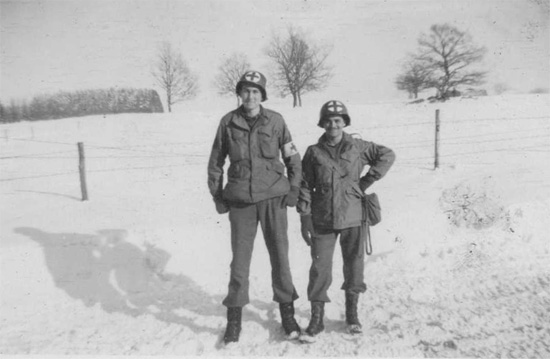
S/Sgt Everard R. Hicks with a fellow medic in the Belgian Ardennes, December 1944-January 1945.
The text and some images contained in this Testimony are courtesy of S/Sgt Everard R. Hicks (ASN:35257572) who served as a member of the Medical Detachment with the 924th Field Artillery Battalion in WW2. The MRC staff are truly grateful to this Veteran for kindly sharing his personal reminiscences with us and our readers. The additional help received from his son Marc is hereby acknowledged and very much appreciated too.
